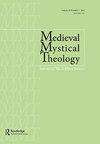‘Rain of God’s Letters’ – Glagolitic Alphabet as a Mystical Tool?
IF 0.3
0 RELIGION
引用次数: 0
Abstract
ABSTRACT The Glagolitic alphabet was intended as a political and religious tool for the Slavs in the ninth century. This paper argues that despite its quick suppression, Glagolitic – arguably composed by Constantine The Philosopher (a brother of Methodius) from Thessaloniki – could have been a mystical tool. The relevant historical context and hagiographical material are explored to establish the alphabet’s origins. Uspenskij’s distinction regarding the palaeographic and ideographic origins of scripts is then followed. A short survey of the most relevant graphic features of some letters, their arrangement in the alphabet, their names, and their possible origins is accompanied by a more in-depth discussion of some key graphemes and their mystical potential. Tschernochvostoff’s theory of Glagolitic being woven upon three basic Christian symbols is elaborated on and expanded. Finally, the stunning (acrophonic) naming of the letters is shown as coding comprehensible Christian, and arguably mystical, messages in Proto-Slavic.“上帝的文字之雨”——格拉哥里字母表作为神秘工具?
格拉哥利字母是9世纪斯拉夫人的一种政治和宗教工具。本文认为,尽管格拉哥利文很快就被压制了,但它可能是一种神秘的工具——可以说是由塞萨洛尼基的哲学家君士坦丁(Methodius的兄弟)创作的。相关的历史背景和圣徒的材料进行了探索,以建立字母表的起源。接下来是Uspenskij关于文字的古文字和表意文字起源的区分。对一些字母最相关的图形特征、它们在字母表中的排列、它们的名字和它们可能的起源进行简短的调查,并伴随着对一些关键字素及其神秘潜力的更深入的讨论。切尔诺霍斯托夫的格拉哥利语理论是由三个基本的基督教符号编织而成的。最后,这些字母令人惊叹的(acrophonic)命名被显示为原始斯拉夫语中可理解的基督教信息,并且可以说是神秘的信息。
本文章由计算机程序翻译,如有差异,请以英文原文为准。
求助全文
约1分钟内获得全文
求助全文

 求助内容:
求助内容: 应助结果提醒方式:
应助结果提醒方式:


